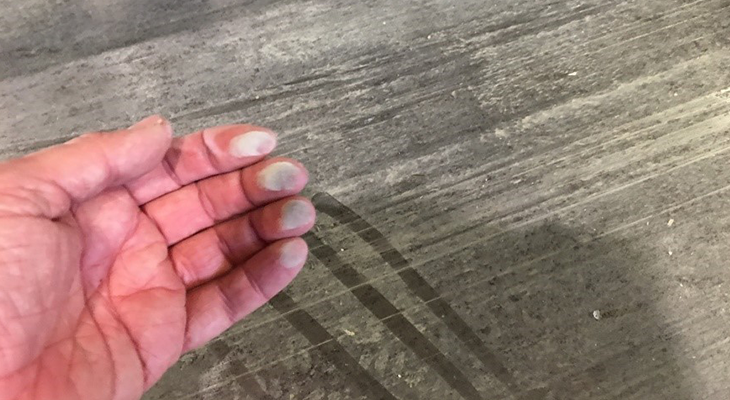
Stop concrete dusting! One of the problems you do not want to face during the production of concrete is dust. Dusting concrete can cause durability and finishing problems to the surface of your concrete product along with possible health problems to your workforce.
Ecoratio wants to assist you in problems and we want to share our knowledge, so you can deliver concrete products without dust and the best quality.
In this article we will describe the reason your concrete is dusting and give you some concrete dusting solutions.
What causes dusting concrete?
To stop concrete dusting it is essential to know what causes concrete dusting. Dusting is the release of powders when the concrete moves or is being touched. The dust occurs when the surface of the concrete is not strong enough and is friable and porous.
A porous surface is weak and fragile and in turn can lead to more dusting.
When the surface of the concrete is weak, the chance of dusting is increased. There are several causes that make the concrete surface weak.
Examples are:
- Exposure to inclement weather;
- Insufficient curing of the concrete surface;
- Weak / poor concrete mix design;
- Carbonation through CO2 and H2O exposure;
- The use of tarnished / dirty aggregates;
- The use of too much water during the finishing of the production process;
- Release agents can also cause dusting concrete. When too much agent is applied, the excess oil is spread over the surface making it porous.
Stop concrete dusting: solutions
Ecoratio wants to assist you in stopping concrete dusting problems with the following tips that reduce the chance of dusting concrete. Here you find some tips that can be the solution for concrete dusting:
Tip #1
Use the best available materials to cast your concrete. The aggregates that you are going to use need to be clean and of uniform shape to create the concrete mix design;
Tip #2
Bleed water on top of the surface will weaken the quality of your concrete.
A correctly design concrete mix with the lowest possible water cement ratio to achieve the desired workability will result in less bleed water and less dusting;
Tip #3
The most obvious solution to prevent dusting concrete is to let your concrete cure properly. When the concrete is properly cured, the structural integrity of the concrete will be at its best.
Curing Tips:
- Do not let your concrete dry out too fast!
- Do cover your newly cast concrete with polythene or damp hessian
- If covering with polythene make sure the ends of the formwork are also covered to avoid a ‘wind tunnel’, wind can rapidly dry out the concrete surface which will lead to dusting
- Do use an aliphatic alcohol
- Do use a concrete curing agent on the fresh concrete to seal the surface to stop moisture leaving the concrete too fast
- Once demoulded keep the concrete element out of direct sunlight and wind for as long as possible
- Once (and only) when the initial setting and hardening of the concrete has taken place then spray a fine water mist to keep the surface moist
Tip #5
Avoid using additional water when finishing your fresh concrete.
The surface may finish easier and it may look like you have achieved a good quality surface finish, but this normally only leads to severe dusting and concrete surface strength problems and should be avoided at all costs.
Tip #6
Do not use too much release agent on the moulds. In addition to dusting, it causes other problem such as surface voids and discoloration. Use one of Ecoratio’s release agents or custom-built spray systems for the best results.
To avoid and stop dusting concrete and you will contribute to a better quality of concrete. More information on how to stop dusting concrete and how Ecoratio can help you can be found in the Quality Guide in concrete production. Other common problems in the concrete industry are also discussed.



